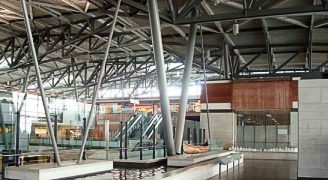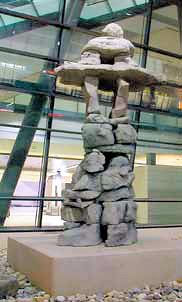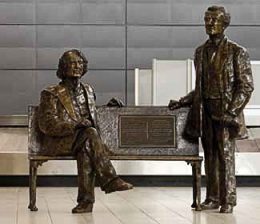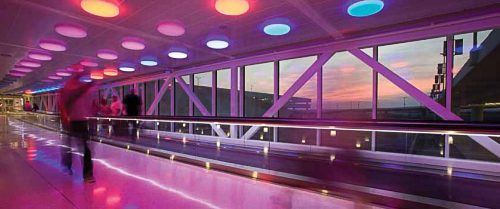 |
“We had a distinct advantage with a brand new facility,” says communications and media relations manager Susan Sullivan. “The artwork wasn’t retrofitted into an existing space. It was selected, created and installed as an integral part of the new airport, especially the terminal’s interior architecture.”
Proposals for individual pieces were reviewed before ground was broken for the new facility. An initial pool of 550 applicants was narrowed to 52 finalists in early 2005, and requests for proposals were issued for 40 works. By early 2006, plans for artwork to fill the airport’s new Col. H. Weir Cook Memorial Terminal Building were set.
|
Minnight Flight by Martin Donlin, poem by Joyce Brinkman |
The community established a non-profit foundation to support art at the airport, and IAA contracted with it to provide services up to $38,000 and reimbursable expenses up to $98,000 through the end of 2010. The foundation then subcontracted Blackburn Architects for the $38,000 of services.
A Seat at the Design Table
An unusual degree of consideration for artwork in the overall facility’s design proved to be a tremendous advantage, notes Julia Moore, public art administrator for Blackburn Architects.
“Usually it’s a matter of determining where artwork will be placed, even when a new facility is being built,” Moore explains. “Aero Design Group looped the art right into the design process. They realized from the beginning how wonderful it could be. The early and constant interface made a big difference in the final outcome.”
Sullivan cites Jet Stream, a suspended display of perforated aluminum and stainless steel by Rob Fisher, as an example of the effective interplay between the art and architecture in Indianapolis’s new terminal. “The piece really complements the height of the ceiling in the main Civic Plaza,” she explains. “They deliberately play off each other.”
|
Cardinals by John van Alstine |
“There were times that installation of art had to bring construction to a temporary halt,” explains Moore. “In other instances, art elements had to be delayed to help the construction flow.”
Installation of floor-to-ceiling glass murals by Martin Donlin proved to be the most difficult to schedule. “The panels were fabricated in Germany, shipped by sea and rail to a glass factory in Minnesota, then onto a local installation shop,” Moore recounts. “The ship left port in Germany one week late, so the schedule was really tight.” Fortunately, only three of the 114 panels broke during transit and installation.
Installation of the large terrazzo floor mosaic in Civic Plaza – The Great Circle Route by Lynn Basa – was expedited due to schedule delays just before it.
“With so many pieces to install and so much other construction going on, it was amazing everything got done on time,” recalls Sullivan.
Autum Prairie Morning by Dixie Friend Gay
TechnoArt
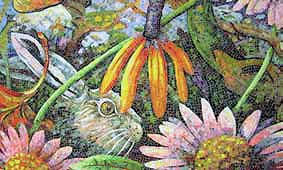
Connection, a $446,000 work of light and sound by Electroland, was years in the making. The result, reports Sullivan, delights “kids” – both young and old.
As airport visitors walk or ride the automated people mover through the airport’s main pedestrian bridge, a succession of multi-colored LED “dots” tracks their paths overhead. When two paths intersect, the intervening dots connect in an “explosion” of contrasting colored lights; “digital bells” reinforce the visual with sound.
“The art is actually generated by the activity of the people on the bridge,” explains Cameron McNall, principal of Electroland. “It’s very dynamic as people connect and disconnect with total strangers.”
The 140-foot long piece capitalizes on the linear and opposing traffic flows of pedestrians. “It provides a very pure art experience,” notes McNall. “There are no other distractions in the long bridge.”
|
Breath by Greg Hull |
Because Connection contains Electroland’s most literal and accurate tracking capabilities to date, designers added systems to temper the display when pedestrian traffic is especially heavy or frenetic. “We were mindful to make it entertaining, but not distracting or stressful,” explains McNall. Pre-set patterns run when pedestrians aren’t present to trigger the tracking action.
“The view of the bridge at night from the roadway is spectacular,” notes Sullivan. “The glowing, changing lights are beautiful.”
Visitors are enthralled with the piece, she reports. “Sometimes it breaks into a random show of light and sound that makes you want to dance,” she notes. “It’s fun for us to watch people enjoy it.”
The cameras, computers and electrical infrastructure needed to operate the artwork are contained in a remote climate-controlled room with internet and video connections to Electroland’s office in Los Angeles. According to McNall, only two incidents have required the firm’s attention, and both were caused by power interruptions at the airport. “It’s built with very robust software and industry-standard hardware components,” he describes. “It’s designed to run for years to come without any maintenance.”
The airport has a precautionary incident-based service contract with Electroland, with no ongoing operational costs.
McNall says it’s a privilege to have a piece in the airport’s art collection. “The projects are very well curated, and there’s such a nice progression of diverse works,” he notes. “Going to an airport used to be an exciting event. Now, many feel like bus stations. Indianapolis’ new airport is beautiful; the art helps bring back that special aura air travel used to have.”
The collection will be showcased this spring, when Indianapolis International hosts Arts in the Airport, an American Association of Airport Executives workshop, April 15-16.
On the Drawing Board
Although the City of Indianapolis doesn’t require infrastructure projects to include public art, the airport spent almost 1% of the total terminal building cost on artwork – a common figure for such ordinances. Blackburn stayed just under its allotted budget.
One major piece has yet to be realized: an illuminated 25-foot by 100-foot sculptural element for the airport entrance. “It’s a very conceptual piece that spells out IND in its negative space,” describes Givens. “It’s designed to be viewed from the ground and from the air.”
Preliminary site work is complete: Power is in place and the soil has been compacted to support a large-scale piece. Funding the rest of the six-figure project is the next step.
“Indianapolis is a generous community that supports the arts in so many ways,” relates Givens. “I’m sure in time we’ll find the money. It’s a wonderful piece we hope will become an icon for the airport – maybe even the city.”
|
Algonquin birchbark canoe, built by Peter Miranda |
Oh, Canada
It’s not hard to discern the aesthetic theme at Ottawa International Airport. Respect for the area’s culture and heritage pervades its entire art collection.
“We’re an airport built by the community, for the community,” explains Krista Kealey, vice president of Communications & Public Affairs. “The artwork reflects our strong local orientation.”
A three-level water feature in the Passenger Terminal Building emphasizes the importance of water to the area. “Visually, the water feature warms up the terminal’s modern architecture,” says Kealey, whose department administers artistic matters at the airport. “And the sound of the running water is very soothing.”
The feature begins on the third floor, with an artistic depiction of the rocky Chaudière Falls, which flows into a representation of the Rideau Falls, near the departure lounge on the second level. It, in turn, flows into an interpretation of the Rideau Canal, which houses an authentic Algonquin birchbark canoe.
|
Replica of interior inukshuk designed and built by Peter Katorka and Peter Irniq |
The first-floor portion of the water feature is a tribute to the Rideau lock system that connects Lake Ontario and the Ottawa River. The names of all 49 locks are carved into a limestone wall behind the escalator domestic passengers ride into the arrivals hall. Water flows from the second story over the name of the final lock, Ottawa, in the main gathering area.
“The Ottawa lock has become the signature image for the airport and city,” Kealey relates. “It’s served as the backdrop for everything from paparazzi photos of celebrities to formal wedding portraits. It’s even been the site of a few marriage proposals.”
The water feature also provides an easy-to-find meeting spot, she adds, with visual and auditory cues for visitors with hearing or sight impairments.
It’s OK to Touch
Still water on the third floor encircles an inukshuk designed and built by Peter Katorka, a Nunavut elder, and Peter Irniq, Commissioner of Nunavut. Inukshuit are man-made stone landmarks historically used for navigation or to mark special sites. The Inuit would look through the hole in the center of an inukshuk for direction. The airport’s inukshuk points to the runway that takes passengers north. The rocks used to create the traditional artwork came from various Nunavut communities and were assembled in a traditional design representing travel. First Air commissioned and donated the piece in 2003.
|
Bronz sculptures of Sir John A. MacDonald and George-Etienne Cartier by Jeremie Giles |
“We’re not the kind of airport with ‘hands-off’ art people view passively from behind a rope,” explains Kealey. “We like to see visitors interacting with the art. That’s how we know they’re enjoying it.”
In addition to its architectural art elements, the airport maintains two art galleries in the domestic hold room areas. The galleries feature works by local artists who are not represented elsewhere in commercial galleries. Even though exhibits change every three months, there’s a two-year waiting list to show there.
“It’s a great opportunity for local artists to showcase and sometimes sell their work,” notes Kealey. “It’s also another chance for the airport to give something back to the community.”
A 3-D Tribute
Many of Ottawa International’s significant pieces arrived for the opening of the airport’s new terminal in 2003. A bronze sculpture of the airport’s original namesakes, however, was commissioned in 2007 to celebrate the airport’s 10th anniversary. Sculptor Jérémie Giles combined metals from the old terminal with metals from the new terminal to form a statue of Sirs John A. Macdonald and George-Étienne Cartier. Visitors often sit between the two historic figures, and its patina is already developing as people rub its surface – more good signs of public approval as far as the airport is concerned.
The sculpture/bench was placed in the arrivals area to welcome visitors new to Ottawa and provide local residents a place to greet returning travelers. “We envision children anxiously awaiting a long-overdue visit from their grandparents or a family waiting for the return of a soldier after months of being away,” noted past chairman Jim Durrell, at the work’s unveiling.
Gotta Go by Gordon Huether
And the Winner Is … Jacksonville (Again!)

Jacksonville International Airport received national acclaim this summer, when one of its works was named a top public arts project of 2008 by Americans for the Arts. The winning piece – Gotta Go, by Gordon Huether – is actually two separate works, each 35 feet tall. An oversize image of a female traveler fills the rampside window of Concourse C while its companion male piece (an image of the artist himself) punctuates the end of Concourse A.
The president of Americans for the Arts praised the Florida airport for using public art to “make citizens stop, think and appreciate an artistic moment, no matter how brief.”
The sheer scale of Gotta Go makes travelers stop and take notice, but its execution and clever use of materials keep them looking, explains Cabeth Cornelius, program coordinator for the JIA Arts Commission.
“In each piece, the traveler’s luggage is made of kinetic dichroic acrylics that change color in the light,” explains Cornelius. “The artist usually works in glass; but he used thick, fade-resistant HDTE film to make it more affordable for us.”
Total cost of the award-winning piece was roughly $200,000.
The River by Peter Hite
Also Lauded
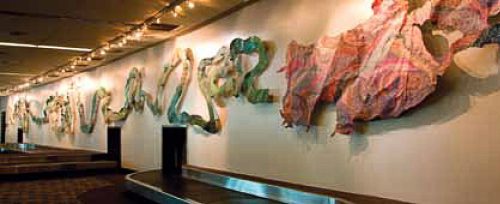
The River, a 500-foot long collage winding through the airport’s baggage claim area, won similar honors from Americans for the Arts two years ago. The piece, by Houston artist Peter Hite, is an aerial depiction of six major rivers (including the local St. Johns) created with postage stamps from 40 different countries. Assistants hand-trimmed the scalloped white borders off approximately 300,000 stamps to allow their colors to blend, and then glued each one to cut aluminum forms.
According to Hite, The River is a metaphor for the stream of world culture; the stamps used to create the various waterways depict significant people, places and events from different countries, portraying the forces that have shaped the world over the last century.
Total cost for the project was $240,000.
“We don’t have the monumental budgets that some airports have, but we have some very interesting works,” says Cornelius, noting that The River was Hite’s first public art commission.
The airport’s permanent collection includes 11 major works. The Arts Commission also maintains a gallery in the main courtyard of the terminal and four art kiosks in the connector between the ticketing/baggage claim areas and the main terminal. The Haskell Gallery, now 11 years old, predominantly features the work of local talent and artists from the airport’s service area.
“They’re often emerging artists,” explains Cornelius. “Many have ended up with works in galleries across the country and overseas in foreign embassies. You never know who’s going to see the art as they pass through the airport.”
Mother by Mark Estlund
The Nitty Gritty
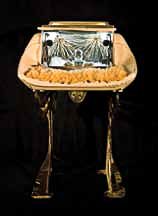
In addition to coordinating exhibits and major commissions, Cornelius maintains Jacksonville International’s permanent collection. Recently that entailed finding a vendor to clean and polish a 14-foot bronze sculpture outside the airport’s main entrance. Sculptor Javier Marin combined physical characteristics from Mexican, Native American and Asian cultures to create the head of an “international” woman. The piece, titled Hoy es Hoy (Today is Today), is considered a literal representation of the airport’s value of multi-culturalism.
The JIA Arts Commission purchased and installed the work in 2006 for $150,000, and the Jacksonville Airport Authority built a new entrance pavilion to house it.
Cornelius is also receiving proposals for new artwork to adorn the connector bridge between baggage claim/ticketing and the airport’s new courtyard concourses. The $200,000 allotted for art came from funds remaining when construction of Concourses A and C finished last fall under budget.
The bridge itself, built in 1960s, will also be updated with a budget not to exceed $8 million. “It’s really dark and depressing, with low ceilings and a downward slope,” describes Cornelius. “The completely redesigned, open space will provide a more congruent feel between the old and new spaces.”
Construction of the new connector bridge, managed by RS&H, is expected to begin in January to facilitate completion by the end of 2010.
According to Cornelius, proposals for artwork to embellish the corridor look promising. “One uses sunlight as its medium,” she notes.




